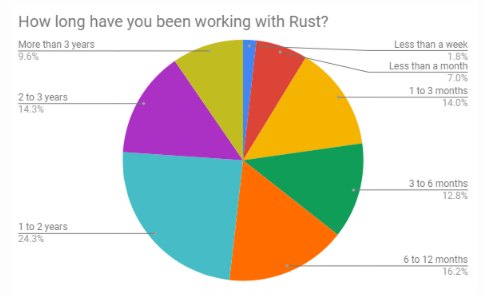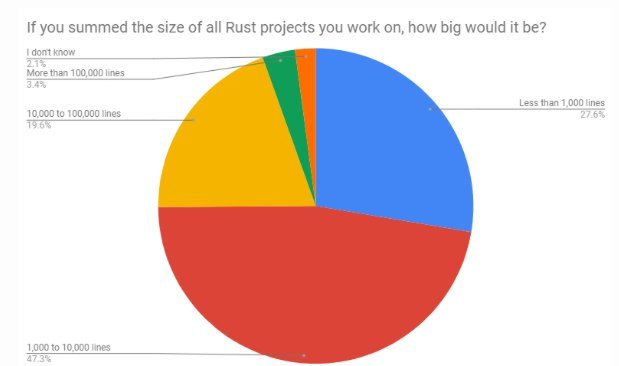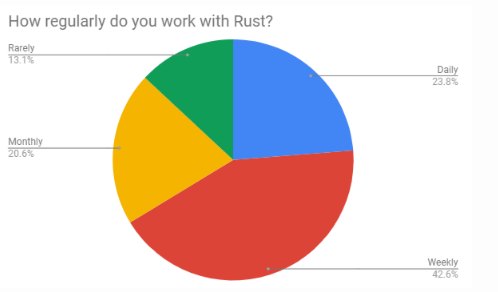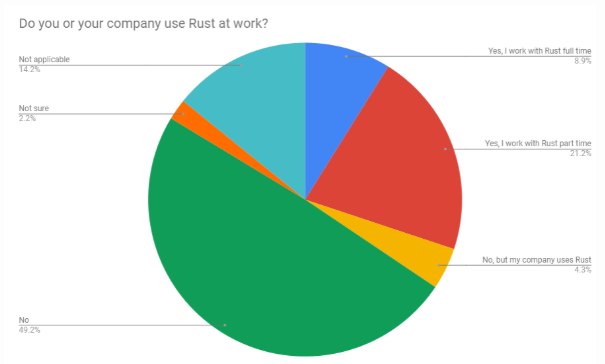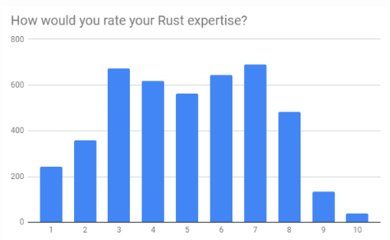| Rust Survey Revelations |
| Written by Janet Swift |
| Friday, 07 December 2018 |
|
The 2018 Rust Survey attracted more responses than in previous years and a greater proportion of respondents were active users of the language. Rust’s has conducted its third annual survey. One difference this year was its availability in multiple languages. The results from 14 non-English languages totalled 25% of all responses and helped set a new record of 5991 responses. Three quarters of those surveyed use Rust, up from 70% in 2017. Of the remainder two thirds had never used it and the remaining third (8% of the total) had stopped using it. Rust is a young language so the pie chart showing how long respondents has worked with Rust goes from "Less than a week" to "More than 3 years". The largest pie slice was 1 to 2 years (24%). Around 23% were "new" users, having worked with it for 3 months or less, 29% had 3-12 months experience and 25% 3 years or more. Another test of experience was the number of lines of code written in it. Almost half of respondents who could answer the question fell into the 1,000 to 10,000 band (red). The Rust blog post comments: Rust projects are continuing to trend to larger sizes, with larger overall investments. Medium to large investments in Rust (those totally over 10k and 100k lines of code respectively) have grown from 8.9% in 2016, to 16% in 2017, to 23% this year. Yet another indicator that Rust is bedded in is that two thirds of respondents work with Rust on a daily or weekly basis: Given what we've already seen it comes as a bit of a shock that Rust adoption in the workplace is pretty limited. Almost half of respondents don't use Rust at work (shown in green)- and this proportion increases when you take into account the "Not applicable" pie slice (turquoise):
The Rust blog post has a more positive spin: Rust continues its slow-and-steady growth in the workplace. We’re now seeing year-over-year growth of full-time and part-time Rust, growing from last year’s 4.4% full-time and 16.6% part-time to this year’s 8.9% full-time and 21.2% part-time, a doubling of full-time Rust commercial use. In total, Rust commercial use grew from 21% to just over 30% of Rust users. The survey also asked how long it took devs to become productive in Rust. The finding was that: Over 40% of Rust users felt productive in Rust in less than a month of use, and over 70% felt productive in their first year. Unfortunately, there is a noticeable struggle among users, as over 22% do not yet feel productive. In terms of expertise on a scale of 1 to 10, going from beginner to expert there were two peaks: one around a “3”, just above beginner, and another at “7” (intermediate). In response to the question what programming languages are you comfortable more devs nominated Python than Rust. Rust took 2nd place while C, the language Rust is deigned to replace came in 3rd: There's more in the survey report on versions of Rust used, workflow and toolchain in the survey, plus findings related to the Rust community.
More InformationRelated ArticlesRust 1.26 Adds Existential Types Rust Hits Stable 1.0 - So What? Survey Reveals JavaScript Trends Stack Overflow Publishes Largest Ever Survey Are Perl Programmers Different?
To be informed about new articles on I Programmer, sign up for our weekly newsletter, subscribe to the RSS feed and follow us on Twitter, Facebook or Linkedin.
Comments
or email your comment to: comments@i-programmer.info
|
| Last Updated ( Friday, 07 December 2018 ) |


